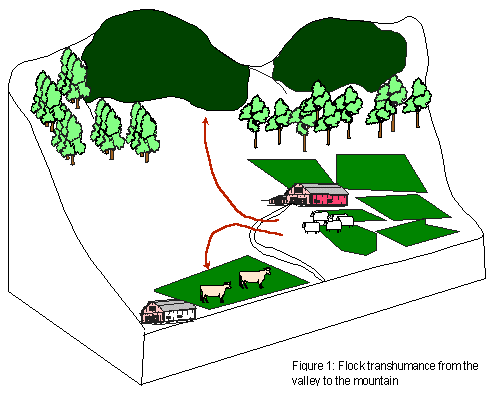 The James Hutton Institute
The James Hutton Institute
This page is no longer updated. The Macaulay Land Use Research Institute joined forces with SCRI on 1 April 2011 to create The James Hutton Institute.
CIMA-Granja Modelo de Arkaute. Apdo. 48 01080 VITORIA-GASTEIZ (Spain)
SYSTEM
The basis of this livestock system is the Latxa ewe, a local
dairy breed exploited in the Basque Country since remote ages, which, because
of that, is perfectly adapted to the environment characteristics, mainly
the climate (Atlantic climate with a rainfall of 900-1500 mm/year) and
the altitude (0 to 1500 m.a.s.l.).
Nowadays, in the Basque Country there is a population of about 247,000 ewes distributed in 4,250 flocks, from a total population of 750,000 if we consider both sides of the Pyrenees.
PRODUCTION OBJECTIVES
At the present time, about 50 % of the total milk production of the
Basque Country is transformed into cheese at the farms. This fact implies
some positive aspects:
a) The added value generated in this process is kept within the farmer's environment.
b) The transformation requires a larger work force, so it contributes
more in the maintenance of rural population.
Starting from the data corresponding to the net incomes of 16 flocks
in advisory programs, 7 selling milk and 9 on-farm processing, some differences
can be shown between both types of farms (Table 1): although for the net
incomes per labour unit (L.U.) there are scarcely no differences, as the
requirement of work when making cheese is greater, the total incomes in
this group of farms is more important than in those selling milk to the
dairy industries.
Table 1: Incomes according to the farm aptitude.
|
n |
L.U./farm (n) |
Net incomes/L.U. (ECU) |
Net incomes/farm (ECU) |
|
| MILK FARMS |
7 |
1.1 |
13,854 |
15,239 |
| CHEESE FARMS |
9 |
1.7 |
13,469 |
22,223 |
L.U.= Labour Unit Milk price=0.81 ECU /l Cheese price=10-11.5 ECU/kg
CHARACTERISTICS OF THE SYSTEM
STRATEGY
Taking into account these characteristics, and in order to overcome the limitations of the system, an strategy based on transhumance has been developed to integrate different grazing resources during the whole production cycle (Figure 1).

It generally consists on a short movement of the flocks from the valley,
where they are during winter and spring, to the mountain pastures, where
they will pass the summer and the autumn. These two periods can be defined
by the following points:
|
Valley |
Mountain |
| -190-250 days per year (Dec-Jul) | -120-175 days per year (Jun-Nov) |
| -Productive stages: | -Productive stages: |
| Lambing | End of milking |
| Milking | Mating |
| Mating | Pregnancy |
| -Feeding system based on grazing rented or
own lands, supplemented with:
On-farm hays or silages Off-farm hays |
-Ewes free-grazing communal natural pastures (500 to 1500 m.a.s.l.) mixed with cattle and horses. (Sheep represent 60% of the total stocking intensity). |
| Concentrates -This is a consequence of: Limited grazing resources Climatological conditions in winter. |
-Vegetation: characteristic of humid mountain pastures dominated by Agrostis, Festuca species, and shrubby cover from 0 to 75% of Erica, Calluna... |
| -Sheep graze on medium-high sloped hillsides with a medium-high brushy cover. |
Nevertheless, these characteristics and parameters can vary according with the particular degree of management and production intensification of the specific farm (Figure 2).

PRESENT CONSTRAINTS
The near future of this livestock system will happen marked by a series
of factors that are affecting the present situation, as they are the following:
1. Progressive decrease in the number of farmers as a consequence of:
-High average age of the shepherds (45-50 years old)
-Rural population movement, leaving farming activities (during the period 1985-1994 the annual decrease of agricultural work varied from 4% to 6% according to different sources).
2. Decrease in the use of mountain pastures due to:
-Better living conditions requested by farmers.
-Return of the wolf (Canis lupus) over the last 6 years, after
an absence of more than 30 years.
Due to these two points, there is the risk of the disappearance of the
traditional system, and Latxa ewes being substituted by foreign breeds,
more productive in intensive systems.
3. On the other hand, the increasing environmental concern over the
last 7 years has led to nearly 10% of the total surface area of the Basque
Country being declared protected areas, which the local government plans
to extend to 17.5% in the medium term. The role of livestock production
in the sustainability of these areas is important, so they can help in
maintaining the Latxa traditional system.
REFERENCES
Besga, G.; Albizu, I.; Rodriguez, M.; Onaindia, M.; Domingo, M.; Amezaga, I. -1996- Pasture productivity and utilization in communal grazing land in the Basque Country. 9th Meeting of the FAO working group for mountain pastures. Banska Bystrica (Slovakia) 20-23th June.
Marijuan, S.-1996- El pastoreo en comunales: Estudio del comportamiento de las ovejas y la utilización de los recursos disponibles. Tesis Master of Science. C.I.H.E.A.M. Zaragoza (Spain).
Oregui, L.M.-1992- Estudio del manejo de la alimentación en los rebaños ovinos de raza Latxa y su influencia sobre los resultados reproductivos y de producción de leche. Tesis Doctoral. Servicio Central de Publicaciones del Gobierno Vasco.Vitoria-Gasteiz (Spain).
Ruiz, R.; Oregui, L.M.; Bravo, M.V.-1996- Farm characteristics and milk production of dairy ewe flocks in the Basque Country. 4th International Livestock Farming Systems Symposium.Tjele (Denmark). 22-23th August.
Urarte, E.; Gabiña, D.; Arranz, J.; Arrese, F.; Gorostiza, P.; Sierra, I.-1989- Las razas ovinas Latxa y Carranzana.I. Sistemas de producción. ITEA Producción Animal nº 84. Zaragoza (Spain).